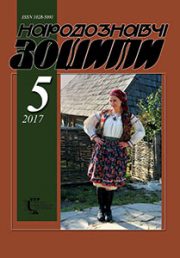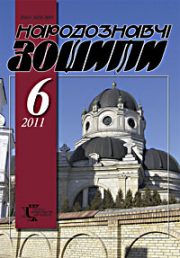The Ethnology Notebooks. 2023. № 3 (171), 792—804
UDK 391:[746.3:687.268.6](477.83:474.5)
DOI https://doi.org/10.15407/nz2023.03.792
KUTSYR Tetiana
- ORCID ID: https://orcid.org/0000-0002-6522-0640
- Candidate in Art Studying (Ph.D.)
- Researcher,
- The Ethnology Institute of the National Academy of Sciences of Ukraine,
- Folk Art Department,
- 15, Svoboda Avenue, 79000, Lviv, Ukraine,
- Contacts: e-mail: sonechko_29@ukr.net
MILAŠIENĖ Daiva
- ORCID ID: https://orcid.org/0000-0002-1833-1217
- Ph.D. in Technical Sciences,
- Senior Researcher,
- Kaunas University of Technology,
- Faculty of Mechanical Engineering and Design,
- Department of Production Engineering,
- 56, Studentu str., LT-51424, Kaunas, Lithuania,
- Contacts: e-mail: daiva.milasiene@ktu.lt
RUKUIŽIENĖ Žaneta
- Ph.D. in Materials Science,
- Lecturer,
- Kaunas University of Technology,
- Faculty of Mechanical Engineering and Design,
- Department of Production Engineering,
- 56, Studentu str., LT-51424, Kaunas, Lithuania,
- Contacts: e-mail: zaneta.rukuiziene@ktu.lt
Abstract. The article was written based on the results of the Ukrainian-Lithuanian interdisciplinary R&D projects «Ornamentation of Western Ukrainian and Lithuanian Folk Textile: Universal and Unique Parameters» (2018—2019) and «Unique Technologies of Ethnographic Textile: Experience of Preservation in Western Ukraine and Lithuania» (2022—2023) (the project have been supported by the Lithuanian Research Council and the Ministry of Education and Science of Ukraine [grant number in Lithuania S-LU-22-5]). These projects focused on the study of both countries’ ethnographic textiles, and the techniques of their making and decoration, one of which was embroidery. The embroidery had been used in the decoration of traditional fabrics throughout Europe. The study of Ukrainian embroidery features compared with common history countries contributes to the establishment of our country as part of the European Community, which determines the study’s relevance.
The article`s purpose is to reveal the characteristic features of the combination of woven decor with embroidered in woven towels of the western part of Ukraine and Lithuania on the basis of exhibits developed in the museums of both countries.
The study subject is the traditional woven towels of the western part of Ukraine and Lithuania, in the decor of which various embroidery stitches are used, and the object is the principles of combining weaving and embroidery in the traditional towels of both countries, the artistic features of their decor.
The main study method was a comparative analysis of embroidery in the decoration of towels in the western part of Ukraine and Lithuania, which allowed us to reveal fundamental differences in approaches to its use. The structural analysis of the study subject, the methods of generalization and reconstruction, as well as the method of art studying analysis, which helped in determining the common and distinctive features of the embroidery decoration in the woven towels of both countries, were also important.
The results. Some basic principles of combining woven and embroidered decor were discovered: imitation — the creation with the help of decorative stitches the imitation of woven patterns; complementary, in which embroidery is used to add, diversify, or connect woven fabrics; accented — when an ornament or a single motive created with embroidery stitches is the accent of the item’s composition, part of which is also a woven decor. The work with Western Ukrainian and Lithuanian items showed that the first two principles are more common in domestic towels and the last one is in Lithuanian ones.
Keywords: Ukraine, Lithuania, traditional towel, weaving, embroidery, ornament, pattern, motive.
Received 16.06.2023
REFERENCES
- Zakharchuk-Chuhai, R.V. (1988). Ukrainian Folk Embroidery. Western Regions of UkrSSR. Kyiv: Naukova dumka [in Ukrainian].
- Kara-Vasylieva, T. (2008). History of Ukrainian Embroidery. Kyiv: Mystetstvo [in Ukrainian].
- Zaichenko, V. (2018). Embroidery of the Cherginiv region. Towels. Catalog of the V. Tarnavskyi Chernihiv Historical Museum collection. Kyiv: Rodovid [in Ukrainian].
- Lozynskyi, T. (Ed.) (2017). Towels of Dnipro Region of Ukraine. Lviv: The Institute of Collecting Ukrainian Art Items at the NTSh [in Ukrainian].
- Prychepii, Ie., & Prychepii, T. (2007). Eastern Podillia Embroidery. Kyiv: Rodovid [in Ukrainian].
- Voroniuk, L., & Shchybria, V. (Eds.) (2023). Imperishable. Ukrainian State Symbols in the Folk Embroidery and Weaving. Kyiv: Master-print [in Ukrainian].
- Nykorak, O. (2004). The Ukrainian Traditional Folk Cloths of XIX and XX cc. Interior Cloths (Based on Materials from Ukrainian Western Regions) (Part I). Lviv: Ethnology Institute of NAS of Ukraine [in Ukrainian].
- Bernotaite-Beliauskiene, D. (2016). Lithuanian Folk Textiles. Towels. Vilnius: Lietuvos Dailes muziejus [in Lithuanian].
- Bernotaite-Beliauskiene, D. (2018). For Body and Soul: Towels (Part 1). Folk Culture, 5, 76—85 [in Lithuanian].
- Bernotaite-Beliauskiene, D. (2018). For Body and Soul: Towels (Part 2). Folk Culture, 6, 66—74 [in Lithuanian].
- Benedikiene, R. (2019). Dzuki rags: A set of Towels of the Alytus Local History Museum. Alytus: Alytaus krastotyros muziejus [in Lithuanian].
- Kumpikaite, E., Nykorak, O., Nenartaviciute, E., Herus, L., Kutsyr, T., Kozakevych, O., Milasiene, D., & Rukuiziene, Z. (2022). Similarities and Differences of Lithuanian and Western Ukrainian Folk Towels. AUTEX 2022 Conference Proceedings. Lodz University of Technology.
- Kutsyr, T. (2023). The Embroidered Decor of Western Ukrainian and Lithuanian Towels: a comparative aspect. The XXI Century Culture: Research, Memorization, Development: Conference Proceedings (Pp. 153—157). Kyiv: V. Dal [in Ukrainian].
- Kumpikaite, E., Nykorak, O., Nenartaviciute, E., Herus, L., Kutsyr, T., Milasiene, D., Kozakevych, O., & Rukuiziene, Z. (2023). Comparative Analysis of Western Ukrainian and Lithuanian Folk Towels. Fiber&Textile in Easten Europe (Pp. 1—13).DOI: 10.2478/ftee-2023-0013
- Nykorak, O., Herus, L., Kozakevych, O., & Kutsyr, T. (2022). Ukrainian-Lithuanian Research & Development Projects on Ethnographic Textile Investigation: Establishment of International Cooperation, Study of Sources and Artifacts, Exchange of Experience. Ukrainian Art Discourse. Special Issue dedicated to European integration topics (Pp. 39—45) [in Ukrainian].
- Savoniakaite, V. (1998). Fabrics in Rural Culture: Lithuanian Geometric Ornaments of the XIX—XX Centuries. Vilnius: Alma littera [in Lithuanian].
- Lobachevskaia, O. (2013). Belarusian Folk Textiles. Artistic bases, Relationships, Innovations. Minsk: Belaruskaia navuka [in Russian].





